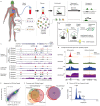ChIP-seq of plasma cell-free nucleosomes identifies gene expression programs of the cells of origin
- PMID: 33432199
- PMCID: PMC7610786
- DOI: 10.1038/s41587-020-00775-6
ChIP-seq of plasma cell-free nucleosomes identifies gene expression programs of the cells of origin
Erratum in
-
Author Correction: ChIP-seq of plasma cell-free nucleosomes identifies gene expression programs of the cells of origin.Nat Biotechnol. 2021 May;39(5):642. doi: 10.1038/s41587-021-00831-9. Nat Biotechnol. 2021. PMID: 33479494 No abstract available.
-
Author Correction: ChIP-seq of plasma cell-free nucleosomes identifies gene expression programs of the cells of origin.Nat Biotechnol. 2021 May;39(5):642. doi: 10.1038/s41587-021-00853-3. Nat Biotechnol. 2021. PMID: 33649570 No abstract available.
Abstract
Cell-free DNA (cfDNA) in human plasma provides access to molecular information about the pathological processes in the organs or tumors from which it originates. These DNA fragments are derived from fragmented chromatin in dying cells and retain some of the cell-of-origin histone modifications. In this study, we applied chromatin immunoprecipitation of cell-free nucleosomes carrying active chromatin modifications followed by sequencing (cfChIP-seq) to 268 human samples. In healthy donors, we identified bone marrow megakaryocytes, but not erythroblasts, as major contributors to the cfDNA pool. In patients with a range of liver diseases, we showed that we can identify pathology-related changes in hepatocyte transcriptional programs. In patients with metastatic colorectal carcinoma, we detected clinically relevant and patient-specific information, including transcriptionally active human epidermal growth factor receptor 2 (HER2) amplifications. Altogether, cfChIP-seq, using low sequencing depth, provides systemic and genome-wide information and can inform diagnosis and facilitate interrogation of physiological and pathological processes using blood samples.
Conflict of interest statement
A patent application for cfChIP-seq has been submitted by the Hebrew University of Jerusalem. R.S., I.S., J.G., and N.F. are founders of Senseera LTD.
Figures















References
Publication types
MeSH terms
Substances
Grants and funding
LinkOut - more resources
Full Text Sources
Other Literature Sources
Medical
Research Materials
Miscellaneous

